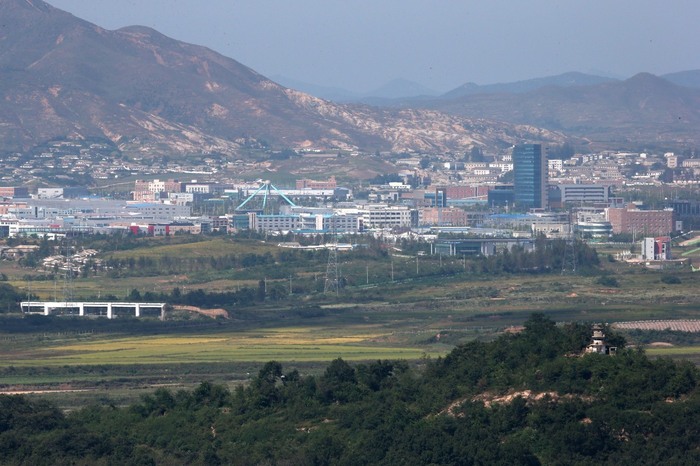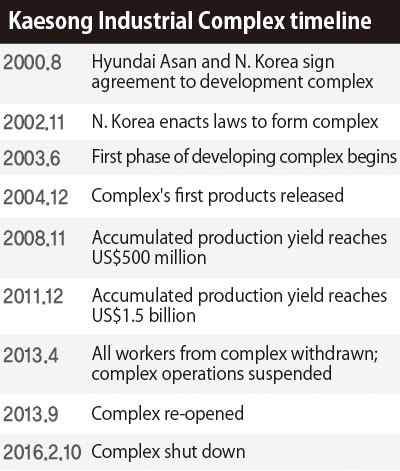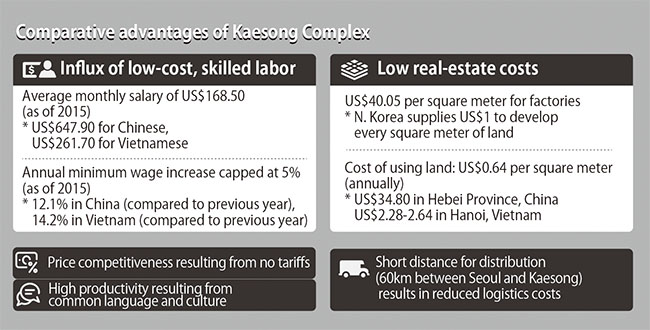Posted on : Feb.10,2019 16:11 KST
Modified on : Feb.10,2019 16:25 KST
 |
|
North Korean workers at a shoe production facility in the Kaesong Industrial Complex on July 20, 2007. (photo pool)
|
Recent report reveals clear economic benefits complex provides to South Korea
As of Feb. 10, it will have been three years since the South Korean government, under former president Park Geun-hye, closed the Kaesong Industrial Complex in response to North Korea’s nuclear weapon tests and missile launches. The possibility of resuming operations at the Kaesong Industrial Complex and tourism to Mt. Kumgang has emerged as one of the potential corresponding measures the US could take to compensate North Korea for closing its Yongbyon nuclear facilities, leading up to the two countries’ second summit on Feb. 27 and 28.
After this possibility was raised this year and the leaders of South and North Korea mentioned the resumption of operations at the Kaesong Complex, the tired argument about government handouts being lavished on North Korea has reared its ugly head once again in South Korea. Last month, Rep. Lee Eon-ju, a lawmaker with the Bareunmirae Party, wrote on Facebook that “the creation of the Kaesong Complex moved companies and jobs out of the country” and that “there are strong suspicions that that a portion of the wages paid to workers were used to develop North Korea’s nuclear program.” On his YouTube channel, former Liberty Korea Party (LKP) leader Hong Jun-pyo alleged that the North Korean policy of the Kim Dae-jung and Roh Moo-hyun administrations was to give North Korea handouts that were then used to build the North’s nuclear weapons.
The argument that the wages paid to North Korean workers at Kaesong led to the development of North Korea’s nuclear program is only an assumption, and no one has provided objective grounds or evidence to back it up. But the narrative about handouts to the North led the international community to conclude that bulk cash had been funneled from the Kaesong Complex into the North’s missile and nuclear weapon development programs, and that belief now functions as an obstacle to reopening the complex.
In order for efforts to persuade the international community of the need to reactivate the Kaesong Complex, experts believe, there first needs to be an accurate assessment of the complex’s economic benefits and its impact on inter-Korean relations as well as the formation of a consensus inside South Korea.
“Before we take our case to the international community, the ruling and opposition parties need to hash out the conditions under which they’re willing to reopen the Kaesong Complex,” said Shin Han-yong, president of the Corporate Association of Gaesong (Kaesong) Industrial Complex, during a debate on Jan. 24 that was hosted by the Korea Peace Forum.
In a recently released report titled “Kaesong Industrial Complex: The Benefits Outweigh the Costs,” the Gaesong (Kaesong) Industrial District Foundation (GIDF) argues that “The debate about the economic costs and benefits of the Kaesong Complex is heating up without an accurate understanding of the complex’s value. We provide an empirical analysis that contradicts the narrative that reopening the complex would be giving handouts to North Korea and demonstrates instead that the complex is highly beneficial for South Korea.” In this article, the Hankyoreh draws upon the foundation’s report, along with data and research from Statistics Korea and various institutes, to ascertain the truth of the claim that the Kaesong Complex is basically a handout to North Korean regime.
 |
|
A view of the Kaesong Industrial Complex (Hankyoreh archives)
|
Giving 5% and getting 95%
From the time the Kaesong Complex first opened in 2004 until it was shut down in 2016, the accumulated value of goods produced there amounted to US$3.23 billion. That figure reflects how much subcontractors operating at the complex were paid for the products they supplied to prime contractors. South Korean companies at the complex produced US$4.60 dollars’ worth of output for every dollar of input. When these figures are converted to the final consumer price, it amounts to 20 or 30 times the value of the investment.
“Everything except the air and water was supplied by South Korea – not only the raw and subsidiary materials but even the vegetables and seasoning used in the complex cafeteria. North Korea’s toll processing fee only represented about 5% of the complex’s production value, with the remaining 95% going to South Korea,” the Kaesong Complex tenant companies explained.
The absolute comparative advantage
 |
|
Kaesong Industrial Complex timeline
|
Even though three years have passed since the Kaesong Complex was shut down, the majority of the tenant companies still plan to return to the complex, the GIDF said. Their rationale is the complex’s overwhelming comparative advantage, economically speaking.
This comparative advantage largely consists of a skilled workforce available for low wages. As of 2015, North Korean workers at the complex were being paid US$168.50 a month. That’s extremely low compared to China (US$647.90) or even Vietnam (US$261.70). Because these workers are supplied by the North Korean authorities, there’s very little worker turnover, and most of the employees there are skilled workers who’ve been on the job between five and 10 years. Their annual wage increase is capped at 5%.
The land that North Korea provided the complex cost US$1 per square meter, with an annual usage fee of US$0.64 per square meter. That’s extremely low, compared to China’s Hebei Province (US$34.8) or the Vietnamese capital of Hanoi (US$2.28-2.64).
The Kaesong Complex, which is a duty-free zone, is just 60km from Seoul. This means that vehicles can bring materials into the complex in the morning and then ship finished products out in the afternoon. North Korean workers are highly productive since they share the language and culture of their South Korean
. These are competitive features that are unique to the Kaesong Complex, with no equivalents in other countries.
 |
|
Comparative advantages of Kaesong Complex
|
“Not taking jobs, but making them”
Contrary to the argument advanced by some that the “creation of the Kaesong Complex moved companies and jobs out of the country,” the GIDF contends that the complex sustained South Korean jobs that were on the verge of disappearing and even created new jobs. Over 90% of the tenant companies at the complex are subcontractors that do toll processing. The tenant companies – largely operating on a small scale in a limited group of industries – could no longer compete in South Korea and had been forced to relocate their factories first to China and then to Southeast Asia. When a textile sewing factory sets up a plant overseas, it has to build facilities for creating the raw and subsidiary materials there as well. That causes South Korean producers of those materials to lose customers and may ultimately force them to close.
 |
|
Amount in sales and total assets of tenant companies
|
The approximately 120 tenant companies at the Kaesong Complex sourced their raw and subsidiary materials from some 3,800 South Korean suppliers, supporting 80,000 jobs. If the tenant companies had relocated to China and Southeast Asia, South Korean suppliers would have had to close, but those companies’ presence at the Kaesong Complex maintained and created South Korean jobs, the GIDF argued. “Because of ignorant misconceptions about the Kaesong Complex, there’s a growing, completely inaccurate belief that the complex is taking people’s jobs,” the GIDF said.
The Kaesong Complex brought major benefits not only to SMEs but also to sizable firms and even large corporations – which were the companies that subcontracted work to the tenant companies at the complex. The toll processing rates at the complex in 2015 were similar to the rates in South Korea in 1995. This basically meant that the firms placing orders were paying 20-year-old fees, saving a good deal of money.
What’s being handed out, and to whom?
For South Korean companies, the GIDF asserted, there isn’t an industrial complex anywhere in the world that’s comparable to the Kaesong Complex in economic terms. Viewed in terms of its economic value, therefore, the complex stands to benefit South Korea much more than the North. The GIDF also argues that the Kaesong Complex can provide relief to challenges faced by the South Korean economy, including sluggish domestic demand, the decreasing competitiveness of the manufacturing sector and unemployment among the youth.
“There’s a question I’d like to ask the people who equate reopening the Kaesong Complex with a government handout. What exactly is being handed out, and to whom? There’s no substance to the handouts claim, which fuels a meaningless and counterproductive debate,” said a spokesperson for the GIDF.
By Kwon Hyuk-chul, senior staff writer
Please direct comments or questions to [english@hani.co.kr]













